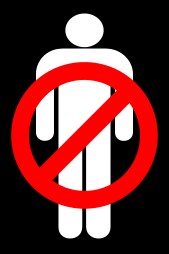African-American youth make up an absurd and out-of-proportion percentage of our prison population. The technical term is DMC – disproportionate minority contact.
Leah Varjacques of the Juvenile Justice Information Exchange gives us a breakdown of the disturbing percentages.
Black youth make up 17 percent of the overall youth population in the United States, but they make up 30 percent of arrested juveniles and 62 percent of minors prosecuted in the adult criminal system, according to the D.C.-based Campaign for Youth Justice.
A look at Illinois shows black youth represent 85 percent of the juvenile justice population, according to the Cook County Circuit Court, even though they only represent one-fifth of the state’s youth population.
As with so many other problems with modern American juvenile justice, we can find the roots of the issue are not merely based in poverty and lack of education, but also in the hysteria of the late 1980s.
The problem was accelerated by the high-crime decades of the 1980s and 1990s that introduced severe laws targeting minors to stem a suspected “superpredator” generation that never came to pass. Youth prisons were built. Now they’re empty. Schools placed more and more police officers or guards in schools, something that is now on the map again following Newtown. Now there are studies claiming the presence of more security in the schools has only worsened the problem.
As it is, about 250 youth are locked up in the Juvenile Temporary Detention Center. Roughly 80 percent of that population is black – and year-to-year stats put the black population in juvenile dentition at roughly 75 percent of the total, which includes about 15 percent to 18 percent Hispanics and 7 percent white.
Drugs, neglect, mental illness and other factors are often rightly invoked when looking at juvenile crime, but one factor beginning to get attention is the role of policing in the equation.
“Why,” asked the board president in Cook County, which covers Chicago, “is there a disproportionate number of black children in the JTDC and what does it say about the way we police our communities?”
Very often, police, called out to crime dens on Chicago’s South and West Sides, sweep streets or target large areas to clear them of crime and blunt the prospects of violent gang reprisals. In doing so, they snatch up a large percentage of black and Hispanic youth, who are most likely to be stuck in the cycle of poverty and poor education that so feeds the criminal justice system.
“It’s not necessarily true,” she said, “that the more people you arrest, the safer the community you have. And you’re more likely to end up in secure juvenile detention if you are African American and display the same behaviors as someone of another race.”
It creates a self-perpetuating cycle. As more youth are rolled through the mill of incarceration the pressure toward recidivism increases. In a recession like the current one jobs are scare enough without having to overcome a recorded juvenile offense. Not only that, but the initial “offenses” are often accused as simply being a way to get the kids “into the system.”
Many neighborhoods are starting to learn that community- and rehabilitation-based efforts can help short circuit this cycle of offense and recidivism.
In the New York City neighborhoods of Harlem, Jamaica and South Bronx, the New York Department of Probation is collaborating with residents, businesses and organizations in what is called the Neighborhood Opportunity Network.
This model attempts to connect probation clients to community-based resources and services to avoid recidivism usually caused by ineffective, cyclical, punitive measures. Such initiatives are examples of what Barrows calls a “renaissance” of community engagement and partnership approaches in dealing with racial and ethnic disparities.
This is where the economic refrain once more enters the picture. Juvenile justice and racial disparity are hardly “sexy” topics in budget meetings, particularly as there is little immediate gratification in either issue.
As a result efforts like the Juvenile Justice and Delinquency Prevention Act (JJDPA) are seeing their resources slashed despite solid track records.
However, with today’s Congressional push for spending cuts – as well as ongoing budget deficits at the state level, especially in Illinois – juvenile justice funding has taken a back seat to other, more popular or welcome projects.
“Our big concern right now has to do with the cuts to juvenile justice funding, part of which gets used to make sure [states] comply with JJDPA,” said Benjamin Chambers, National Juvenile Justice Network spokesman. “Without those resources, they don’t have to comply. And that’s a slippery slope.”
Chambers is 100% correct in his concern. Without motivation to pursue the harder, yet more effective the easier road will often be taken. Most times this means incarceration that does little beyond providing a graduate course in criminal behavior at our society’s long-term expense.
Related articles
- Code Red Homophobia: Homelessness, HIV and Black Religiosity (freethoughtblogs.com)
- Why race matters after Sandy (wagingnonviolence.org)
- From the Bookshelves: States of Delinquency: Race and Science in the Making of California’s Juvenile Justice System by Miroslava Chávez-García (lawprofessors.typepad.com)
- Claims of ‘post-racial’ society and other denials of racism may reflect ignorance of history (psychologicalscience.org)













